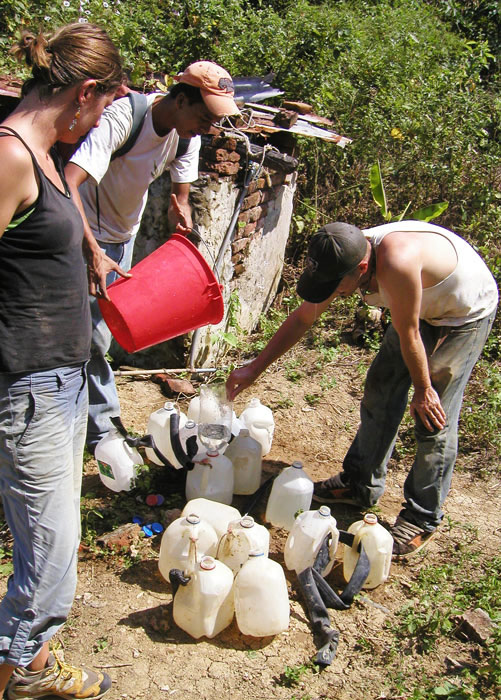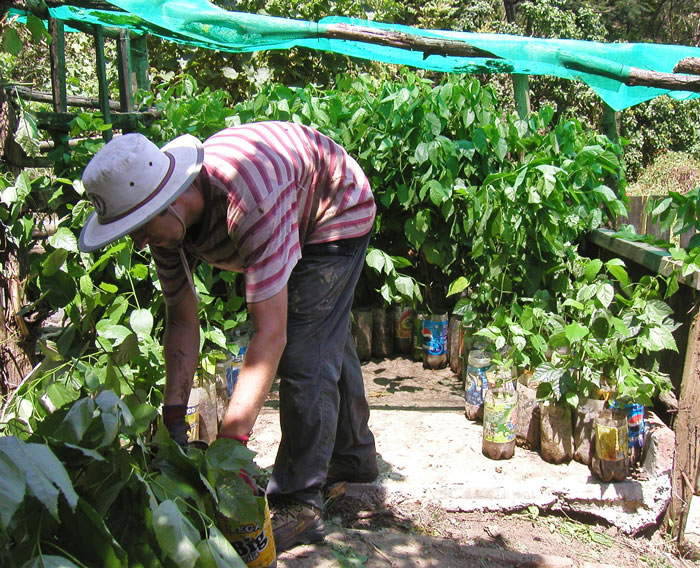May 12-23, 2008
Summary: A good volunteer force and enough rain to keep us from full-time watering allow us to make some real progress on site maintenance and in the greenhouse.
On Monday we split into groups. I take some of the volunteers to water the trees at La Cruz and then take a neighborhood tour, collecting discarded three-liter bottles along the way. Jaime heads out to Kilometro 8 with the other group and they cut more Pelo Caballo branches to use as identification stakes.

Tuesday as one large group we water El Astillero. While there, Palo Santo seeds from some of the trees in the area are collected. We then hike over to the Reales Tamarindos site and water there as well. Upon returning to the house, some of the stakes cut from yesterday are painted red. On Wednesday the La Granja revegetation site is watered. From there we walk to Ricardito’s farm and identify trees planted with red-tipped identification stakes.

Jaime, Amber and Sam fill gallon jugs used for watering at the Reales Tamarindos neighborhood.
Thursday we spend the day at the greenhouse. The seed bed with baby Algarrobos is ready for transplanting. Nearly 200 Algarrobos are moved from the bed to three-liter bottles with a freshly prepared mixture of soil, compost, and sand. Also, a general cleanup is done around the greenhouse and the house compost is dumped off.

Sam and Cameron sift soil while Fuki cuts three-liter bottles.
Friday everyone goes to cut stakes at the Nuevo Globo site as usual. Along the way we find some felled Neem trees at a nearby farm that have similar branches to the Pelo Caballo trees and we decide to use them instead. [INSERT 05-26estacas.jpg, ”] Each volunteer fills a sack of with stakes and then we return to the house for painting. Back at the house, a few hundred stakes are painted.

On Monday we head to the site at the greenhouse to mark more trees with identifying stakes. Our friend Ricardito shows up to help drive a batch of already somewhat large sapling trees over to the greenhouse

On Monday we head to the site at the greenhouse to mark more trees with identifying stakes. Our friend Ricardito shows up to help drive a batch of already somewhat large sapling trees over to the greenhouse extension and we free up a good amount of space inside the greenhouse for next year’s planting.

Cameron loads trees into the greenhouse extension.
An exciting day on Tuesday begins with a visit to the local dump! We are searching for more three-liter bottles. Success! We quickly fill our sacks with scavenged bottles and take off for the greenhouse with the plastic loot. At the greenhouse, the bottles are cut, soil is prepared, and Guachepeli seedlings are transplanted.

That night I leave to Guayaquil for the first in a series of trips which will hopefully result in a shiny, new visa allowing me to stay here for longer. Overnight it rains relatively hard for approximately an hour, enough to provide some crucial water to the trees and allow us to put off watering sites for even longer.
While I’m in Guayaquil, Jaime takes the volunteer on a sight-seeing tour of Leonidas Plaza, suburb of Bahia. Along the way, they search for three-liter bottles. After collecting their share, they head for the greenhouse, where they weed, organize trees and cleanup.
Thursday there’s a bit of a drizzle. Jaime takes the volunteers to El Toro to finish identifying trees with stakes. From there they collect more bottles in the Fanca neighborhood. I spend the day chasing down lawyers, notaries and other locals in my quest for a visa.
On Friday Jaime and the volunteers go to the greenhouse and do some upkeep on the trees that have already grown approximately six months or more in bottles. As the trees grow and times goes by, the dirt in the bottles compacts. When watering, the water drains straight down the sides of the bottle and out the holes in the bottom. The best way to counter this is by topping off the bottles with a fresh soil mixture. This adds new nutrients to the bottles and helps reduce wasting water.
I return to Guayaquil and submit what turns out to be only the first part of my visa application. Another trip will be required next Monday.
Pásalo bien,
Clay

Reader Interactions